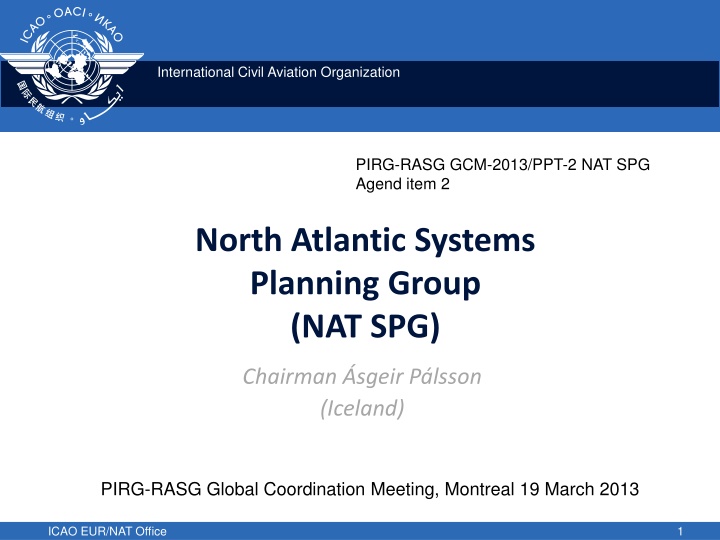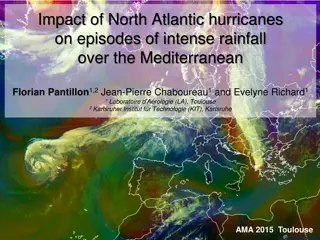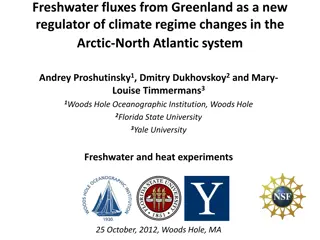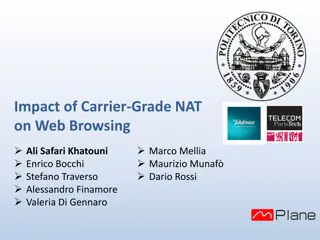Overview of North Atlantic Systems Planning Group (NAT SPG)
The North Atlantic Systems Planning Group (NAT SPG) is a collaborative forum comprising countries like Canada, Iceland, and the United States, along with various aviation organizations. Established in 1965 by the ICAO Council, NAT SPG focuses on enhancing air navigation systems in the region. Their successes include pioneering initiatives like RVSM and MNPS, while also addressing challenges such as resource constraints and harmonization issues. Key priorities involve improving operational efficiency, safety, and inter-regional coordination, with a vision for enhanced technologies and harmonized procedures by 2025.
Download Presentation

Please find below an Image/Link to download the presentation.
The content on the website is provided AS IS for your information and personal use only. It may not be sold, licensed, or shared on other websites without obtaining consent from the author.If you encounter any issues during the download, it is possible that the publisher has removed the file from their server.
You are allowed to download the files provided on this website for personal or commercial use, subject to the condition that they are used lawfully. All files are the property of their respective owners.
The content on the website is provided AS IS for your information and personal use only. It may not be sold, licensed, or shared on other websites without obtaining consent from the author.
E N D
Presentation Transcript
International Civil Aviation Organization PIRG-RASG GCM-2013/PPT-2 NAT SPG Agend item 2 North Atlantic Systems Planning Group (NAT SPG) Chairman sgeir P lsson (Iceland) PIRG-RASG Global Coordination Meeting, Montreal 19 March 2013 ICAO EUR/NAT Office 1
NAT SPG Composition Canada, Denmark, France, Iceland, Ireland, Norway, Portugal, United Kingdom and the United States are NAT SPG Members. Representatives from the Russian Federation and Spain as well as Observers from IATA, IACA, IFALPA, IAOPA, IBAC, IFATCA, and Inmarsat are invited to participate in the work of the NAT SPG. It was established by the ICAO Council in 1965. EUR NAT ICAO EUR/NAT Office 2
NAT SPG Successes First Region to implement RVSM (1997); First Region to develop and implement performance based navigation specification requirements (MNPS); Response to Volcanic Ash (VOLCEX, VA Contingency Plan); Development of comprehensive regional documents (NAT Docs) complementing global ICAO provisions; Constant contributions to the improvement/development of ICAO global provisions. ICAO EUR/NAT Office 3
NAT SPG Priorities Increase capacity and efficiency by implementing reduced horizontal separation minima; Increasing safety of operation through the implementation of new technologies (e.g. data-link, SATCOM etc); Migration from MNPS to RNP Improving inter-regional co-ordination (seamless at the boundaries), with all adjacent Regions and avoiding duplicated requirements for equipment (e.g. ATN / FANS issue); Resolving VA issues. ICAO EUR/NAT Office 4
NAT SPG Roadblocks Limited (lack of) resources (States, Organisations and ICAO Regional Offices); Lack of harmonization with adjacent regions regarding equipment requirements; Working arrangements/ processes and timescales; Conflicting priorities and horizons (tomorrow versus 2025, SESAR vs NextGen, one Region s priorities vs another Region s). ICAO EUR/NAT Office 5
NAT SPG Expectations ASBUs deliver a framework on which to focus work and prioritise tasks By 2025: COM migration from HF to SATCOM data and voice; NAV all flights certified RNP4 or better; SUR mix of ADS-C, ADS-B and radar; ATM - Separation: use of ADS and radar, coupled with DCPC communication separation minima to as low as 5NM; self-separation between appropriately-equipped aircraft; ATM Integration of oceanic and domestic ATC; MET - Standard forecast weather model shared by all parties ICAO EUR/NAT Office 6
ICAO EUR regional structure System approach - keep EANPG RASG EUR Regional coordination of air navigation planning and implementation programmes Regional coordination of GASP implementation RSOOs, AIBs, States, international organisations EANPG sub- groups ICAO EUR/NAT Office 7























